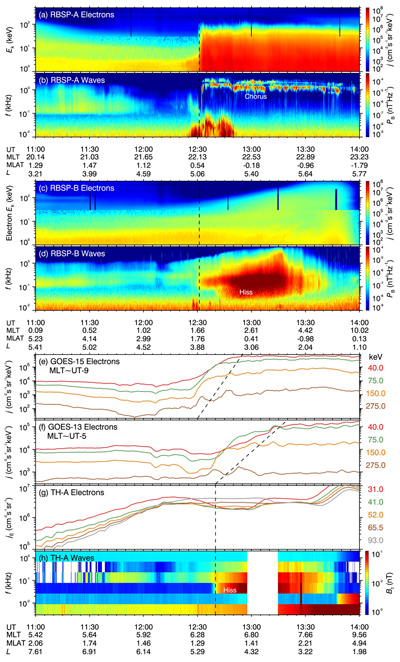
2018 THEMIS SCIENCE NUGGETS
Multipoint observations of nightside plasmaspheric hiss generated by substorm-injected electrons
by Zhenpeng Su
Department of Geophysics and Planetary Sciences
University of Science and Technology of China, Hefei, China
Introduction
The plasmasphere is a torus of cold dense plasma extending upward from Earth’s ionosphere to a distance of several Earth radii. In the plasmasphere, there is a naturally occurring structureless electromagnetic emission with frequencies ranging from tens of Hertz to several Kilohertz, named plasmaspheric hiss. This emission can precipitate high-energy Van Allen radiation belt electrons into the atmosphere and thus reduce the radiation hazard to space-borne systems. Since its discovery in 1969, the origin of plasmaspheric hiss has remained a puzzle to be solved.
Here we present an experimental test of the generation of nightside plasmaspheric hiss during an isolated substorm, using data from the RBSP, GOES and THEMIS missions on 6 December 2016. The three missions with their comprehensive instrumentation together enable simultaneous coverage over a very broad region, and allow a detailed investigation of the nightside hiss generation during the substorm.
Results and Discussion
On 6 December 2016, the sustained intense southward interplanetary magnetic field directly triggered a magnetospheric substorm during 11:00-15:00 UT, while the magnetosphere was quiescent in the preceding ~12 h and the following ~5 h (Figure 1d). Before the substorm, the plasmasphere extended to geosynchronous orbit (Figure 1a). During the substorm injection (Figure 1b), the nightside plasmasphere was peeled off and the plasmapause, the outer boundary of the plasmasphere, shrank to a geocentric distance of ~5.1 Earth radii in the pre-midnight region. After the substorm (Figure 1c), the plasmasphere further eroded to less than 4.5 Earth radii.
| Figure 1. Plasmasphere dynamics observed by THEMIS and RBSP missions: (a-c) schematic diagrams of plasmasphere structures (shadows), spacecraft orbits (colored lines) and hot electron drift paths (black dash-dotted lines) at three stages; (d) solar wind magnetic field Bz and substorm index AE. |
Outside the pre-midnight newly-formed plasmapause (Figures 2a and 2b), the fresh electrons locally excited the structured electromagnetic emission called chorus. At the same time, in the inner post-midnight plasmasphere free from the substorm injection (Figures 2c and 2d), the plasmaspheric hiss exhibited a prompt enhancement in power by up to 2 orders of magnitude. Within locally unchanged plasma, the substorm-enhanced hiss waves must originate from other spatial regions.
One possibility is that the nightside hiss originated from the nightside chorus. According to previous ray-tracing simulations, equatorial chorus can propagate toward higher latitudes and refract into the plasmasphere. However, in the nightside region, the obliquely propagating chorus is strongly damped by the thermal electrons at high latitudes. This scenario is unable to explain the comparable instantaneous amplitudes of nightside chorus and hiss in this event.
A second possibility is that the nightside hiss originated from the dayside chorus. Compared to the nightside region, the dayside region usually has a lower level of thermal electron fluxes and allows weaker damping of the chorus. The dayside chorus can be expected to enter the plasmasphere and then propagate azimuthally to the nightside region. In this event, the substorm-injected electrons drifted from the midnight to the dawn sector (Figures 2a, 2e, and 2f) and the corresponding plasmaspheric hiss was intensified gradually from nightside to dayside (Figures 2c, 2d, 2g, and 2h). The relative timing of dayside and nightside hiss intensifications did not support the dayside chorus as a main source of the nightside hiss.
| Figure 2. Magnetospheric electrons and waves observed by RBSP, GOES and THEMIS missions: (a-d) hot electron spin-averaged differential flux j and wave power spectral density PB recorded by RBSP; (e-f) hot electron differential flux j recorded by GOES; (g-h) hot electron energy flux jE and wave filter bank amplitude Bt recorded by THEMIS. |
A third possibility is that the nightside hiss was destabilized by hot electrons in the outer plasmasphere and then propagated to the inner plasmasphere. Considering that the pre-midnight plasmapause was found to reform at 5.1 Earth radii, and that the measured hiss intensification was located at the magnetic local time of 01:40-04:00, we can expect the source electrons crossing the post-midnight plasmasphere outside 5.1 Earth radii (Figure 1b). Detailed calculations show that this scenario can qualitatively explain the temporal evolution, the frequency dependence and the propagation feature of plasmaspheric hiss observed during this substorm.
Conclusion
Data from RBSP, GOES and THEMIS missions, with supporting modeling, collectively demonstrate that the nightside large-amplitude hiss on 6 December 2016 was generated by the substorm-injected electrons drifting into the outer post-midnight plasmasphere, rather than being linked to the nightside chorus suffering strong damping, or the dayside chorus propagating azimuthally to the nightside plasmasphere. In the past, there have been several studies showing a strong chorus-hiss correlation in the dayside region. Ray-tracing simulations have found that the hiss rays are able to propagate azimuthally over the entire plasmasphere. Our present study, together with early works, implies that both internal instabilities and external sources contribute to plasmaspheric hiss generation. However, the relative importance of these two mechanisms remains to be systematically investigated under different magnetospheric conditions.
Reference
Su, Z., N. Liu, H. Zheng, Y. Wang, and S. Wang, Multipoint observations of nightside plasmaspheric hiss generated by substorm-injected electrons. Geophysical Research Letters, 45, 10921–10932, 2018Biographical Note
Zhenpeng Su is a professor in the Department of Geophysics and Planetary Sciences at the University of Science and Technology of China. His research involves studying the dynamics of the magnetospheric particles and waves on the basis of observations and simulations.
 Please send comments/suggestions to
Emmanuel Masongsong / emasongsong @ igpp.ucla.edu
Please send comments/suggestions to
Emmanuel Masongsong / emasongsong @ igpp.ucla.edu


